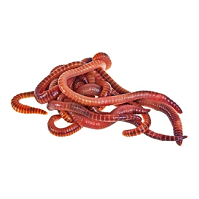Red worms: Step-by-step guide
Red worms: Step-by-step guide
Blog Article
Every Little Thing You Need to Find Out About Red Wigglers for Composting
Red wigglers, or Eisenia fetida, play a pivotal role in the realm of composting, transforming organic waste into important dirt changes. Their special organic attributes allow them to grow in various conditions, making them an excellent option for both amateur and seasoned composters alike. Understanding their requirements and advantages is crucial for establishing an effective vermicomposting system. The process of setting up a worm bin and preserving it can present challenges. To effectively harness the possibility of these worms, one have to check out the complexities of their care and management.
What Are Red Wigglers?

(red wiggler worms for sale)
Belonging To The United States and copyright, red wigglers are surface-dwelling microorganisms that like damp, warm environments abundant in decaying natural matter. Their diet plan consists primarily of decomposing plant product, food scraps, and various other organic debris, which they eat and break down effectively. As they absorb this product, they produce nutrient-rich castings that enhance dirt fertility.
Red wigglers are hermaphroditic, possessing both male and female reproductive body organs, and can recreate swiftly under ideal problems. In general, red wigglers are crucial factors to the process of recycling natural waste right into important garden compost.
Benefits of Utilizing Red Wigglers
Using red wigglers in composting systems supplies various advantages that boost both the effectiveness of waste monitoring and the top quality of the resulting compost. These worms, clinically called Eisenia fetida, are specifically effective at breaking down raw material, transforming cooking area scraps and backyard waste into nutrient-rich compost at an accelerated rate.
One of the main advantages of making use of red wigglers is their capacity to consume large quantities of organic material, often refining their weight in food waste daily. This high intake price leads to faster decomposition and decreases the volume of waste sent to garbage dumps. Moreover, the spreadings generated by red wigglers are abundant in necessary nutrients, beneficial microorganisms, and enzymes, making them an excellent fertilizer for gardens and plants.
In addition, red wigglers prosper in a range of atmospheres, making them adaptable for both indoor and outdoor composting systems - red wigglers. Their visibility in a garden compost container helps to aerate the material, preventing smells and advertising a healthy composting process. Overall, using red wigglers not just contributes to effective waste monitoring yet likewise supports lasting horticulture practices through the production of high-quality garden compost
(Lake Hickory Worms,)
Establishing Up Your Worm Container
To successfully establish a worm bin, it is vital to pick an appropriate container that satisfies the requirements of red wigglers while providing a favorable atmosphere for composting. An ideal container can be made from plastic, wood, or metal, with a capability of a minimum of 1 square foot for every single pound of worms.
Make sure the container has ample water drainage openings to avoid excess moisture, as red wigglers thrive in a damp, but not waterlogged, environment. red wigglers. The bin should also be ventilated to supply adequate air flow, stopping anaerobic conditions that can hurt the worms
A suitable place for the worm bin is an amazing, dark area, devoid of direct sunlight and severe temperature levels, as red wigglers like a temperature level variety of 55 to 77 degrees Fahrenheit.
Before presenting the worms, prepare bedding materials such as shredded paper, cardboard, or coconut coir, which will certainly give both environment and food. Moisten the bedding gently to produce an inviting atmosphere for the worms. Consider positioning a cover on the bin to keep humidity and minimize insects, while ensuring it can be quickly eliminated for upkeep.
Feeding and Care Standards
Feeding red wigglers is a critical element of maintaining a healthy and balanced composting system. These worms flourish on a varied diet plan, primarily made up of organic products such as fruit and vegetable scraps, coffee premises, and crushed eggshells. It is essential to prevent Discover More feeding them meat, dairy products, and oily foods, as these can develop undesirable odors and bring in insects.
When presenting food to your worm bin, cut or shred materials right into smaller sized pieces to promote quicker decay. Beginning with percentages to evaluate the worms' intake rate, progressively enhancing the amount as they adapt. It is a good idea to alternate feeding places within the container to encourage complete mixing and aeration of the garden compost.

Troubleshooting Common Issues
Preserving a prospering worm composting system can sometimes provide challenges that require attention and troubleshooting. Typical issues consist of an unpleasant odor, which often suggests overfeeding or the visibility of anaerobic conditions. To correct this, lower the amount of food added and ensure proper aeration by mixing the bedding product.
An additional frequent issue is the retreat of worms from the bin. This can happen as a result of too much moisture or inappropriate ecological problems. Regularly examine the wetness levels, going for a moist yet not soaked consistency, and maintain ideal temperatures in between 60-80 ° F(15-27 ° C )to produce a comfy habitat for your red wigglers.
Pests, such as fruit flies, can additionally invade worm containers. red wigglers. To combat this, cover food scraps with a layer of bed linens or shredded paper to discourage flies from laying eggs. Additionally, make sure that any food added is fresh and devoid of mold, which can bring in unwanted parasites
Finally, if your worms appear inactive, look for tension variables such as temperature variations or inadequate wetness. Addressing these typical concerns will assist keep a healthy and effective worm composting system.
Conclusion
In summary, red wigglers, or Eisenia fetida, play a crucial duty in lasting waste management via vermicomposting. Appropriate configuration and upkeep of a worm container, along with adherence to feeding standards, make sure a growing ecological community that minimizes landfill payments.
Report this page